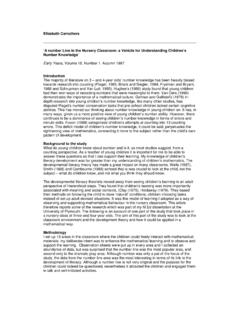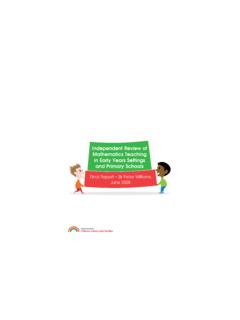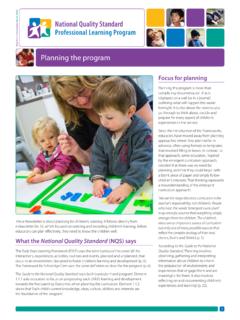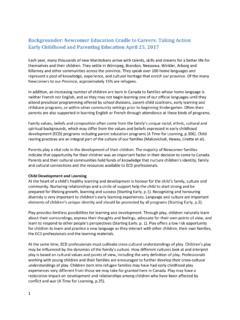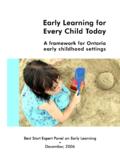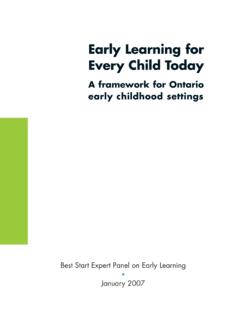Transcription of Children thinking mathematically: PSRN essential …
1 Children thinking mathematically : psrn essential knowledge for early Years practitionersChildren thinking mathematically : psrn essential knowledge for early Years practitionersFirst published in 2009 Ref: 00861-2009 BKT-ENDSI CMM 12-2009 DisclaimerThe Department for Children , Schools and Families wishes to make it clear that the Department and its agents accept no responsibility for the actual content of any materials suggested as information sources in this publication, whether these are in the form of printed publications or on a these materials, icons, logos, software products and websites are used for contextual and practical reasons.
2 Their use should not be interpreted as an endorsement of particular companies or their websites referred to in these materials existed at the time of going to check all website references carefully to see if they have changed and substitute other references where National Strategies | early YearsChildren thinking mathematically : psrn essential knowledge for early Years practitioners Crown copyright 200900861-2009 BKT-ENContents1. Introduction32. Enabling environments63. Children s mathematical graphics124. Numbers as labels and for counting185. Calculating266. Shape, space and measures327. Transitions408. Examples of problem solving in action from psrn essential Knowledge479.
3 References513 The National Strategies | early YearsChildren thinking mathematically : psrn essential knowledge for early Years practitioners Crown copyright 200900861-2009 BKT-EN1. IntroductionProblem Solving, Reasoning and Numeracy in the early Years Foundation Stage This booklet focuses on Children s mathematical development, which is explored in the area of learning and development entitled Problem Solving, Reasoning and Numeracy ( psrn ) in the early Years Foundation Stage (EYFS) (DCSF, 2008).The EYFS recognises that creativity and critical thinking are important in all areas of learning and are as integral to mathematics as they are to painting or dance.
4 Reflecting on the narratives and examples of Children s mathematics throughout this booklet, it is clear that creativity plays a significant role in mathematical thinking and four themes of the EYFS, A Unique Child, Positive Relationships, Enabling Environments and Learning and Development, underpin everything that practitioners do with Children from birth to five. They also underpin every chapter in this booklet. The Practice Guidance for the early Years Foundation Stage (page 63) and the psrn card remind practitioners that A Unique Child will seek patterns, make connections and recognise relationships through finding out about and working with numbers and counting, with sorting and matching and with shape, space and measures and that Children use their knowledge and skill in these areas to solve problems, generate new questions and make connections across other areas of Learning and Development.
5 The EYFS guidance then goes on to set out some of the important considerations for Children s learning in psrn relating to Positive Relationships, Enabling Environments and Learning and Development. Reference is made to these throughout this booklet. What mathematics do you think Children are exploring here? How could you enhance this?4 The National Strategies | early Years Children thinking mathematically : psrn essential knowledge for early Years practitioners00861-2009 BKT-EN Crown copyright 2009 Why do we need more guidance on psrn ? The independent review of mathematics teaching in early Years settings and primary schools, known as the Williams review (DCSF, 2008a), recommended that the DCSF should commission a set of materials on mathematical mark making and Children s mathematical development to be used to support early Years practitioners professional development.
6 The review emphasised that although the EYFS provides guidance on developing mathematical understanding through imaginative in this area seem to be missed. This finding is confirmed by the early Years Foundation Stage Profile (EYFSP) results, which demonstrate that relatively few Children (36 per cent) attain point 8: uses developing mathematical ideas and methods to solve practical problems, in any of the three mathematical assessment scales. The EYFSP scores also reveal that boys do less well than girls especially in the area of calculation: In practical activities and discussion, begins to use the vocabulary involved in adding and subtraction (EYFSP).
7 It is essential therefore that practical opportunities are available on a regular basis within small group activities and throughout the play environment, and that these activities are built on (see example below). Developing calculationString beans and containers were set on the carpet for talk time and Brandon (4 years 3 months) decided to shell beans and put them in a container which he had chosen. He self-initiated his own counting. Quietly talking to himself he divided the beans into each section of the container, 11 more now many more? 5 now as he counted the empty spaces. Brandon was using counting to calculate how many more he needed.
8 Brandon s teacher regularly puts out quantities of objects to talk 5 The National Strategies | early YearsChildren thinking mathematically : psrn essential knowledge for early Years practitioners Crown copyright 200900861-2009 BKT-ENabout and involves the group in talking about increasingly larger quantities. Mathematical vocabulary is deliberately used but in meaningful contexts to give the Children tools to articulate their knowledge of on Mark Making Matters Mark Making Matters (DCSF, 2008b) was the first part of the set of materials recommended by Williams. It aimed to raise awareness of the importance of young Children s mark making as a tool for communication and thinking across the six areas of learning and development, while strengthening the quality of provision for mark making in Communication, Language and Literacy and in psrn .
9 A local education authority advisor, involved in raising the profile of calculation through supporting reception class teachers in their understanding of Children thinking mathematically through their own graphics, stated, Maths is much higher profile now. Teachers and practitioners are talking about calculating significantly more; boys are representing mathematics and are extending themselves much more. This has had an impact on the way in which teachers and practitioners work: their expectations of the Children are much higher. The Williams review (DCSF, 2008a) also stressed that effective early Years pedagogy should value and support Children s own mathematical graphics.
10 Children s own mathematical graphics help them understand the written language of mathematics and how it can be s in this booklet? This booklet takes Mark Making Matters further and extends and develops the concepts explored there with particular reference to the three strands of psrn : Numbers as labels and for counting Calculating Shape space and measures. There are chapters on each of these, as well as the opening chapter on enabling environments for psrn . Chapter 3: Children s mathematical graphics lays the foundation for the remainder of the booklet, which concludes with consideration of transition between EYFS and year 1. High-quality experiences of mathematics are the entitlement of every child The examples in this booklet include Children from a range of backgrounds and communities.
